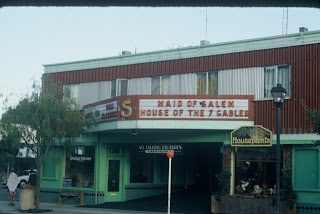The Vitaphone
 |
| The Vitaphone Theater, as it looked when I attended |
The Saratoga theater, with its distinctive red 'S' logo in the center of the two marquee signs, was built in 1948, out of one of the many World War 2 era quonset surplus huts all over the area. It was truly one of a kind.
 |
| Saratoga Theater, circa 1948. Note the quonset structure in the rear |
It wasn't until the 1970s that Pat Moore - an eccentric film enthusiastic and native of Santa Cruz, CA - came along and re-purposed the theater. His time in Hollywood as a grip and occasionally, a film extra, served him very well for the job. He had exclusive access to archival film that nobody else could get their hands on. He networked with Hollywood archivists and even Hollywood stars, and in doing so, gave his audiences access to films and newsreel footage, some of which had not been screened in decades. Pat was full of stories - for instance, he was an extra in John Huston's 1951 adaptation of The Red Badge of Courage.
When the Moores first moved into the theater space, they christened it 'The Vitaphone,' after an old-time film audio synchronization process. At first, they had all kinds of problems with teenagers coming in and slashing the seats with pocket knives and other acts of vandalism. In response, the Moores did something really unusual (even by today's standards): they turned their theater into a private club. For just $10 a year, you were issued a special card making you a member, and the Moores reserved the right to refuse service to anybody. This could have backfired on them, but it didn't. It had the effect - largely due to the sorts of films they screened - of filtering through a respectful but enthusiastic crowd. In its time, although it only seated about 400, the Vitaphone in Saratoga acquired over 100,000 members - among them John Wayne, Charleton Heston, and Olivia de Haviland. And yes, those stars visited the theater.
 |
| Such a fun movie |
The auditorium itself was a long, domed structure. It looked cavernous to me back then. I recall the stucco design, and the murals depicting palm trees oasis and deserts - a kind of north African tableau. Faint light sources came up from a wall ledge on either side of the auditorium, and illuminated the illustrations, making them look like sacred cave paintings. There was a single aisle, and it sloped every so slightly down to a stage at the front. Seats on the right allowed you to light up while watching the film. As I sat in the dark of the hall, I lifted my eyes to watch the faint outlines of the trees and the desert vistas along the way. I saw curls of smoke swimming through the projector's ray over our heads. Every so often, from the corner of my eye, I saw something small and fast darting across the ledge below the murals.
What everybody remembers are the memorable talks that Pat gave before each feature. His commentary was always specific to each film theme. He'd come out again between the two features and did something I won't soon forget. He took a can of cat food, and an electric can opener, and, placing them under the microphone, opened the can. Just then, those dark shapes we saw earlier, George, Georgina and Georgette, his cats, ran down either side of the wall ledges. He'd feed them and talk to us. We could hear their purring and their chop licking, loud and clear over the P.A. He'd even 'box' with his cats, down there on the stage.
 |
| Ben Hur's epic visuals dazzled me.. and still do today |
 |
| I still love these guys |
 |
| Cary Grant in 1937's Topper - the 'Beetlejuice' of its time |
The 1980s ushered in an era of blockbusters and theater chains. It got harder and harder to be a theater like the Vitaphone and remain viable. I recall seeing two movies there before the end - the Astronaut chronicle The Right Stuff and the weeper Somewhere In Time (both new releases at that time). I was still under ten years old.
Soon afterward, the Moores' lease ran out and Saratoga's precious institution closed its doors. Pat Moore passed away in 1989, from complications due to lung exposure to film particulates. He got a full write up in the Mercury News lauding his contributions to film history and film education, but to this day, evidence of the Vitaphone's legacy remains scatter-shot, even on the internet. It doesn't even have a Wikipedia entry, not even a mention. That's sad.
Just a few years ago, I hosted a few movie nights: two movies linked with a common theme. Unbelievably, when I began this tradition, I never consciously made the connection between what I was doing and my time at the Vitaphone. I see it clearly now. Sharing love of film, and doing it in a way that brings people together, is not just about satisfying demand. It's not just about getting bodies in seats. It should be about something greater than that. Sure, movie chains 'bring people together' in the most clinical sense, but creating a community through film? That is, for me, the Vitaphone's legacy, at least for me, and reason enough to keep it alive.


Comments